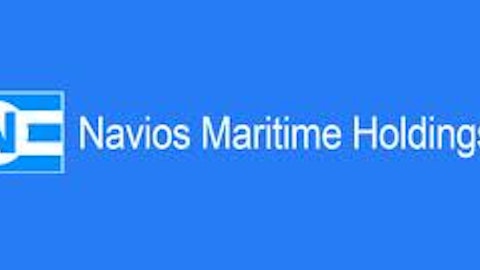DryShips Inc. (NASDAQ:DRYS) is cruising on troubled waters. However, it is not the only ship on the journey to the high seas. Other shipping lines are also traversing the same ocean with surging waves, facing difficulties brought about by the sluggish economy.
But, compared to many of its peers, DryShips Inc. (NASDAQ:DRYS) is more stable because of its well-diversified operation. It is not only involved in the dry bulk shipping segment, but it also has operations in the tanker segment. Both segments have 100% utilization.
DryShips Inc. (NASDAQ:DRYS) has majority ownership of Ocean Rig UDW Inc (NASDAQ:ORIG), which is an offshore drilling contractor. Ocean Rig is involved in offshore drilling in the ultra-deep and rigid water environment segment. It has 10 deepwater drilling units consisting of eight deepwater drillships, and two ultra-deepwater semi-submersible drilling units.
Financially, Ocean Rig UDW Inc (NASDAQ:ORIG) is in a much better position than DryShips. The company generated operating cash flow of about $400 million in the last twelve months. At the current valuation, the stock is trading with a price to cash flow ratio of only 5.7, which makes it a very cheap stock compared to its peers. Several analysts are bullish on the company. Barclays has an overweight rating with a target price of $26 on Ocean Rig.
Ocean Rig UDW Inc (NASDAQ:ORIG) further provides stability to DryShips Inc. (NASDAQ:DRYS). In fact, it was being used to secure a $1.35 billion syndicated loan facility on February 28, 2013. On top of that, DryShips also completed a public offering on February 14 of an aggregate of 7.5 million Ocean Rig shares it owned. This added $123.1 million to its remaining low cash flow of $44 million in 2013.
The aftermath of the recession
Dry bulk shipping was one of the hardest hit industries during the most recent recession that plagued the global economy. Inter-continental trading was down, leading to a sharp decline in demand for dry bulk shipping. As a result, many shipping companies were forced to lower freight rates. Some have even gone as far as offering rock-bottom freight rates below the break-even level.
To make matters worse, the market is faced with excess dry bulk ships due to declining book orders. Meanwhile, deliveries of new ships are increasing. Many new ships are coming in from orders made during the boom years. Some companies have scrapped old ships, but there is still a surplus of ships that further add to plunging freight rates.
Until now, DryShips Inc. (NASDAQ:DRYS) still suffered the effects of the recession. During the first quarter of 2013, its dry bulk voyage revenue significantly declined from $77 million to $45 million. But, on the bright side, revenue from the tanker segment spectacularly improved to $27 million. This is up 285% from the $7 million revenue in 1Q12.
But, total voyage revenue is down quarter-over-quarter from $84 million to $73 million. The company also widened its net loss from $59 million to $114 million. However, it sold four newbuilding drybulk carriers for $75 million. Thus, the adjusted net loss was minimized and improved to only $41 million, which is tantamount to -$0.10 EPS.
While DryShips Inc. (NASDAQ:DRYS) is still struggling with the recession, one of its peers, Navios Maritime Partners L.P. (NYSE:NMM) made an incredible recovery. Navios Maritime Partners L.P. (NYSE:NMM)’s stock was trading as low as $2 during the peak of the recession. However, it steadily recovered to $14 by 2011. Since then, it has stayed flat, but the company offers a substantial dividend yield, which is a great plus. Its beta is also lower than DryShip’s beta, making it a relatively safer bet.
Navios Maritime Partners L.P. (NYSE:NMM)’s debt to equity ratio is only 0.45, which suggests that the company applies strong debt control policy. While it is a Greece-headquartered company, its operations are worldwide. Besides engaging in traditional drybulk commodity transportation, the company also charters its vessels under medium to long-term charters. The stock is up this year, but it lagged the broad market indices, which is why I think Navios Maritime Partners could be a good bet to play the recovery in global drybulk markets.
Future industry outlook
Dry bulk shipping remains the backbone of international trading. The majority of the shipped items are coal and iron ore, which are widely used for construction. Agricultural products like corn, grain, and wheat also contribute to the bulk of worldwide shipments. Therefore, a notable rise in demand for these items will also help push the demand up for dry bulk shipping.
For the last few years, shipments of iron ore and coal have steadily increased due to rising demand for steel. This year, the increased production of iron ore led to the industry fleet growth of 5%-6%. It is expected that higher fleet growth will be further seen in subsequent years, along with the rise of the global economy.
Another major issue that hounds the dry bulk shipping industry is the cheap fleet price, despite the robust demand. The average DryShips freight rate for C4TC is $6,056 per day, down 13% year-over-year. Likewise, the P4TC freight rate is also down 12% year-over-year at $7,055 per day.
This is well below the peak price of more than $100,000 per day during the heydays of 2008. Baltic Exchange, a London-based freight cost assessor, estimated that fleet rates will increase this year to $12,000. By 2014, it will further rise to $20,000 due to rising demand amid expected declining growth of dry bulk ships.
The Baltic Dry Index closed on May 22 at 820 points. This is still far from recovery to the record high of 11,793 back in 2008. However, the index steadily increases and soon it may break the 1,000-point threshold, which was last seen in 2010.
According to Bank of America Merrill Lynch, freight rates will see a significant increase by 2015. This will be triggered by the increasing worldwide demand, while vessel tonnage growth slows down. The demand growth is expected to outpace the fleet capacity additions. The bank further projected that by next year, the sector will see a major shift, and the excess supplies in the market will start to shrink.
However, the recovery of bulk freight rates will neither come overnight nor in a few months. It may take several months, maybe a year or two, before the rates will stabilize toward the profitable level. But, the main point is there is still hope for the dry bulk shipping industry. It may soon rise one day, side-by-side with the industrial boom and growth in the construction and retail sectors.
Bottom line
So, going back to the main issue here, is it time to abandon DryShips Inc. (NASDAQ:DRYS)? Not yet, given the discussion above. In fact, it may be poised for a rebound in the near future. On the contrary, now may be the best time to jump on board to secure a nice position and remain long. DryShips shares are relatively cheap at below $2.50 per share. This is a far cry from the price level of $60-$100 per share back in 2008, prior to the recession.
While DryShips Inc. (NASDAQ:DRYS) is still traveling through stormy waters, the storm is weakening and about to end. Tranquil waters await the dry bulk shipping industry, amid rising demand in commodities in a flourishing worldwide economy. When DryShips enters the recovery phase, shareholders shall enjoy the fantastic ride up.
Therefore, hold on to your life vest. The ship is not sinking, and DryShips will continue to safely cruise through the bad weathers still ahead. This is not a solitary view, but an outlook shared by the majority of the analyst firms recommending a hold.
The article Is It Time To Abandon Ship? originally appeared on Fool.com and is written by Nur Tarkak.
Nur Tarkak has no position in any stocks mentioned. The Motley Fool has no position in any of the stocks mentioned. Nur is a member of The Motley Fool Blog Network — entries represent the personal opinion of the blogger and are not formally edited.
Copyright © 1995 – 2013 The Motley Fool, LLC. All rights reserved. The Motley Fool has a disclosure policy.


